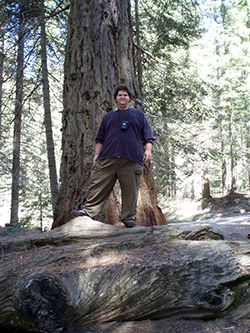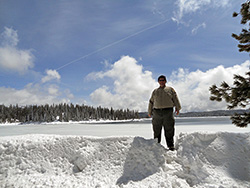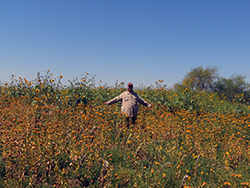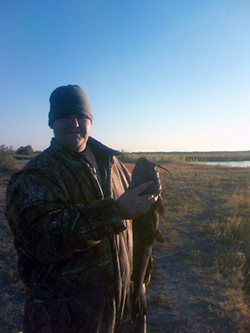



Benjamin Francis Lewis (AKA “Big Ben”), who works out of Fresno, has been the CDFW Central Region’s Upland Game Bird Coordinator position since 2008. Over the past decade, Lewis has had the opportunity to work with several game and non-game species in a wide variety of projects, but his primary focus during his career with CDFW has been upland game birds. He has had the opportunity to work on projects such as banding doves, conducting quail brood counts, planting pheasants, capturing turkeys and staffing upland game check stations. Ben says that every day, he observes and learns something new about upland bird species.
Ben earned his Bachelor of Science degree in biology, with an emphasis in ecology and anatomy/physiology and a minor in chemistry, from California State University, Fresno.
Who or what inspired you to become a wildlife biologist?
As a child, I was the curious sort, always trying to take something apart or figure out how something worked. I also fell in love with the outdoors at a very young age. My mother often reminded me that my first word was “outside” and that I would stand by a door and say it repeatedly until I was let out.
One of my earliest memories is of a small spider, no bigger than a pea, perched atop a piece of canvas. It was a very nice day out, cool with a slight breeze, and for some reason this spider caught my eye. The way it moved with the breeze, rocking and ebbing in perfect sync, mesmerized me. I was trying to understand what it was doing; I thought perhaps it was injured and was moving with the wind due to an inability to resist it? Then in a flash, the spider sprang forth with amazing speed and accuracy and in an instant I realized what it was doing. In its grasp was a fly, one of many that were stationed upon the canvas as well. In that moment in my mind was the feeling of profound understanding, and from that day forward I was hooked.
The desire to understand the world around me is what ultimately led me to the sciences. Of course, some amazing teachers also helped point me in the right direction along the way. A special thank you to Ms. Lawrence, Mr. Slothower, Mr. Scott, Mr. Rouse, Ms. Niboli, Ms. Charnels, Dr. Blumenshine and, of course, my mother, Catherine Lewis.
Who or what brought you to CDFW? What inspires you to stay?
I may be one of the luckiest people on the planet. After graduation I had still not secured a job in the wildlife field, and believe you me it was not for a lack of trying. Up until that point, the only jobs I had were manual labor positions I took to pay for school. My first real opportunity came in the form of an interview with Fresno Wildlife Management Supervisor Kevin O’Connor. At the end of the interview he offered me the scientific aid position and asked me when I could start. I was soon introduced to the rest of the team, and I had never met a more positive and supportive group of people. Soon the group felt less like coworkers and more like family. I enjoyed the work so much that when my seasonal hours were up, I came back as a volunteer until I was hired on again as a seasonal employee and, eventually, as an environmental scientist (wildlife biologist).
What is the most rewarding project that you’ve worked on for CDFW?
This is a tough one because I draw a great deal of satisfaction from many of the projects that I have had the opportunity to work on over the years, from running special hunts that get our next generation into the field, to working on habitat improvement projects.
If I have to pick one project, I would have to say it is providing hunting opportunities to the public through habitat work and putting on special upland game bird hunts. Getting people outside into the field creates a connection with wildlife and a vested interest in conservation and proper management. Working with the public and seeing those connections form has been the most rewarding part of the job.
If you had free reign and unlimited funding, what scientific project would you most like to do?
It would have to involve two of my favorite things: California quail and gallinaceous guzzlers (artificial water sources for wildlife). Starting in the 1950s, gallinaceous guzzlers were built in arid regions of California to provide water for upland game birds. Many of these original guzzlers have withstood the test of time and still serve wildlife today. They are comprised of four main parts: an apron, a water tank, an exclusion fence and brush piles. The apron is a flat surface that is sloped to collect rainwater and drain into the guzzler tank. The water storage tank serves as both a water storage vessel and an access point for wildlife. The exclusion fence keeps cattle from accessing the guzzler area and causing damage, and brush piles create habitat and are essential for providing cover from predators while they are drinking from the guzzler. These oases of life provide stable water sources in a harsh environment and are important to game and non-game species alike, particularly during periods of prolonged drought.
Specific to the California quail, I would love to look at home range, fecundity (the ability to produce an abundance of offspring) survivorship and find a way quantify the importance of the guzzlers in relationship to productivity. To be honest, there is a lot of work I would like to do with upland game birds that range from food studies to reintroductions. However, you know what they say: “Be not afraid of moving slowly, and instead be afraid of standing still.”
What is the most challenging aspect of your career as an environmental scientist?
That would have to be the paperwork -- well, OK, paperwork is a close second. The major challenge is working with the public on human-wildlife conflict. In most cases, the solution to these problems can be summed up with one simple phase: “Leave it alone.” Here in CDFW’s Central Region, we have created a kind of mascot called “Leave It Alone Larry the Lion.” We often talk about creating a public service announcement where kids are walking through the park and find a fledgling of some kind on the ground next to a tree. One child asks the other, “What should we do?” And then Leave it Alone Larry would pop in and say, “Leave it alone!”
More often than not, the best thing we can do when we come across wildlife is to not engage or interact at all.
What is the best thing about being a wildlife scientist?
The fact that it constantly reminds me that life is an adventure -- and an unpredictable one at that. The work can be challenging and many things do not necessarily make sense, but that is what I love about it. If we did not have questions to answer, we would not be able to call ourselves scientists.
Is there a preconception about scientists you would like to dispel?
We are not all huge nerds with glasses and lab coats … though I am a huge nerd, and I have glasses and more than one lab coat in my closet. What I mean to say is that there is no set mold for a scientist. We are a diverse and unique bunch with a common interest in finding answers to questions that baffle us. Oftentimes, we find new questions in the process.
What is it about the work you do that you would most like us to know?
The work I do, I do for you and the resource. We share common goals, no matter who we are or where we come from.